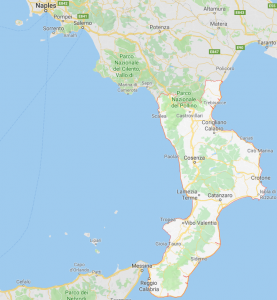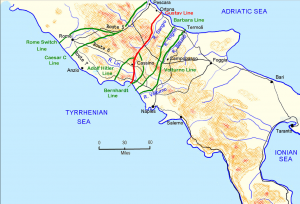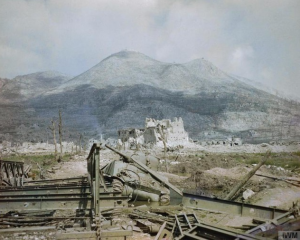The Italian Invasion
The Axis partners Germany, Italy and Japan had two common interests:
Territorial expansion and foundation of empires based on military conquest and the overthrow of the post-World War I international order and the destruction or neutralization of Soviet Communism.
The Battle of Monte Cassino
The Axis partners Germany, Italy and Japan had two common interests:
Territorial expansion and foundation of empires based on military conquest and the overthrow of the post-World War I international order and the destruction or neutralization of Soviet Communism.
Italy was the first Axis partner to give up: it surrendered to the Allies on September 8, 1943, six weeks after leaders of the Italian Fascist Party deposed Fascist leader and Italian dictator Benito Mussolin 9.
Italy surrender in North Africa in May 1943 was followed by the Allied invasion of Sicily. This delivered a fatal blow to Italian self-confidence, which had been undermined previously by the removal of their prime motivator Mussolini and replaced with a government that wanted peace.
On the 3rd September the British invaded Italy and secured the Italian beachheads at Calibria and prompted the Italian armistice four days later. The following day the Americans invaded Salerno, although, it was achieved with much more difficulty in the face of fierce counter-attacks. The Germans reacted swiftly when Italy surrendered, the Italian troops were disarmed and treated harshly if they fought against the Germans, but the Allies actually gained little advantage.
The British government considered Italy an easier invasion option than France, but they hadn’t analysed the terraine. Italy’s mountainous backbone
sends rib-like ridges down to the coast to both east and west. Rivers flow between the ridges. An attacker advancing north from the south is confronted by a
frequent west to east mountain ranges. Its Climate of blazing hot summers and freezing cold winters makes it an unpleasant place to fight, especially
when confronting a pre-prepared defence system. The Germans had defensive positions hued out of rock, stone-built villages converted into strongholds and great tracts of the terrain laid with mines. The German commander, Luftwaffe Field Marshal Kesselring, was a master practitioner of this sort of war.
In overall command of the two invasion armies in Italy was General Sir Harold Alexander, he commanded the British 8th Army which included the 1st Battalion
Royal Sussex Regiment, initially under Montgomery and when he was removed to prepare for the invasion of Normandy, General Sir Oliver Leese and the US 5th Army,
commanded by Lieutenant General Mark Clark, who was acutely conscious of his personal role as the standard-bearer of American arms in Europe.
In the winter of 1943-44, the Allies found themselves confronting the Gustav Line, which crossed Italy south of Rome. For much of its length the line ran along rivers, with the Garigliano, Gari and Rapido strengthening its southern sector.
It crossed Route 6, the Rome-Naples highway, which ran on to Rome along the Liri valley, between the Abruzzi and Aurunci mountains. The entrance to the Liri valley was dominated by the great bulk of Monte Cassino which is crowned by an ancient Benedictine monastery. Behind the monastery, the ground rose even more.
The Allied plan for the breaching the Gustav line was hurriedly conceived. On Churchill’s insistence, it would use an amphibious hook round the German flank,
to be launched before the landing craft were withdrawn for use in Normandy.
American divisions of 5th Army would attack at Cassino to draw German reserves southwards, when successful , an Anglo-American corps would land at Anzio, about 30 miles south of Rome. It was expected that the shock would provoke the Germans into giving up the Gustav Line and falling back north of the Eternal City.
With German reserves duly drawn south, on 22 January 1944 Major General John Lucas’s US VI Corps landed at Anzio and Nettuno. There was almost no resistance. However, Lucas chose to hold a narrow beachhead to slowly build up men and material.
This allowed German reinforcements from the Gustav Line to attack the Anzio beachhead. The fighting at Anzio took on characteristics grimly reminiscent of World War One. It was soon evident that far from Anzio helping the Allies breach the Gustav Line, attacks on the Gustav line would have to be launched to take the pressure off Anzio. The consequence of a narrow beachhead and its inability
to build up troop numbers of sufficient size to repel defenders. 9
The German Defences Gustav Line
The disaster at Salerno was resolved by the arrival of Montgomery 8th Army, who had marched north 300 miles and the exhaustion of the five German divisions who had concentrated on the annihilation of General Clark’s invasion force. On the 1st October 1943 the troops were able to move from the beachhead and capture Naples, the price of victory was high with 7,811 casualties.
Then the Montgomery’s Eighth Army marched up the eastern Adriatic coastal
strip and Clark’s Fifth Army headed up the western Tyrrhenian Sea coastal strip.
Monty had two possible routes north, one via the Appian Way (Via Appia), an ancient Roman Road. This was fraught with German defensive positions, so the alternative, 12 miles inland, route was selected.
Via Appia was a series of flat bottom river valleys leading from Naples, through Aserta and to Rome 125 miles away. These valleys were between two and six miles wide. Although, dominated by high ground each side, it provided a superior route to the Apian Way, also on this route he could take advantage of another Roman Road the Via Casilina, or route 6.
The retreating German army, led by Generaloberst Heinrich von Vietinghoff used the invading troops caution to his advantage, fighting a series of tactical battles to hinder their progress and allow his troops to regroup at the Gustav Line. The tactical battles were enhanced by deployment of fortifications designed the Third Reich’s Civil engineering group, the Todt, known as the Barbara Line, Bernhardt Line and Volturno Line. They consisted of fortified Gun positions, machine gun nests, observation posts into hill sides, laid minefields and flooded valleys, creating defensive belts. These were built by conscripted construction builders, including a 5,000 strong Slovak Engineer division.
All these defences slowed the progress of the invasion forces and it wasn’t until January 1944 that the troops confronted Monte Cassino on the Gustav Line. The terrain at the base of Monte Cassino was not suited for defence, it was impossible to dig trenches and any incoming shell would hit the loose limestone shattering it into 10’s of projectiles, it was very cold in winter and extremely hot in summer. What roads were available were designed for a horse and cart and when it rained armoured vehicles would get stuck in the mud.
The struggle can be summed up by a series of Allied pushes being halted, turned, back or cut-off by the massive obstacle that the German positions provided with their easily defended terrain. The only viable method of taking the stronghold was attacking again and again. The conquest was only successful when the 8th Army from the Adriatic coast arrived, undetected, surprising the Germans with a far more massive force than they expected. The abbey on Monte Cassino was eventually taken on May 18th.
The Germans, their supply lines threatened as the Liri valley were overrun, had retreated under cover of darkness the previous night.
By the end of the Italian campaign, the Germans had lost almost 250,000 troops, killed, missing or captured and the Allies had well over 330,000 casualties 10.
The Italian Armistice 1943
After the Italian armistice in September 1943, Hitler was enraged by their treachery. The German commanders located in Italy triggered operation Asche. This entailed disarmament and neutralisation of Italian soldiers in Italian occupation zones, the Balkin countries, Southern France and Italy, and replacing them with loyal German troops. The Italians did not resist the armistice; Keaselring successfully disarmed five Italian divisions and Rommell repeated it for his Italian divisions. This was a huge army that was dissolved overnight and would have caused a severe issue to the invading forces.
The disarmed soldiers were immediately shipped north to German prison camps. These 720,000 men were put to work as slave labourers where 10% died at the hand of German task masters. There were 85,000 POWs guarded by Italian troops after the armistice 50,000 absconded, but after the German guards took control of the camps 36,000 were recaptured and sent to Germany. The remaining 14,000 joined Partisan units who help the invading forces, by the end of the war there were 232,000 Partisans, of all political persuasions.


